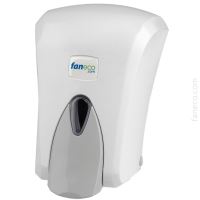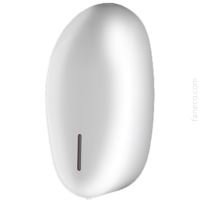Soap dispensers

Which soap dispenser to choose?
At Faneco, we offer various types of soap dispensers designed for use in public bathrooms. Among them are devices intended for use with gel, liquid, or foam products. Some can also be used for disinfectants and lotions. They are made of different materials; devices with capacities ranging from 0.35 to 1.2 liters are available. They all share high quality workmanship, easy operation, and exceptional functionality.
When equipping a public restroom, special attention must be paid to hygiene. The choice of appropriate hand washing products and accessories, such as a soap dispenser, is very important. Which one to choose to ensure the highest level of hygiene and comfort for users?


Soap dispensers for public restrooms - buying guide
Dispensers installed in public restrooms must be of the highest quality. This is primarily due to the need to meet all hygiene standards, as well as to ensure the durability of the equipment.
At Faneco, we offer dispensers made of high-quality ABS plastic and stainless steel.
Plastic is a less expensive solution, but at the same time less durable than steel. However, it is relatively resistant to mechanical damage. Devices made of it will work well in bathrooms with low traffic, for example in small companies or hotel rooms.
On the other hand, in places where more people use the bathroom, a dispenser with high durability should be installed. This is where models made of steel will prove to be effective. They are resistant to both long-term use and acts of vandalism. They do not get damaged even in case of a strong impact; although they may deform due to the application of a really large force, it does not lead to the cracking of the housing. This allows the device to maintain its functionality.
It is also important to pay attention to the method of installation of the equipment and its size. Do you need a durable, vandal-proof soap dispenser? A model suspended on a special frame inside the wall will be exactly what you are looking for. It cannot be dismantled without using special tools and dismantling a part of the wall, which effectively protects the device from theft.
On the other hand, the dimensions of the model should be adapted to the space we have. That is why at Faneco you can also find very compact dispensers designed for small bathrooms.
The most important criteria for choosing a soap dispenser
When choosing a soap dispenser, it is important to pay attention to several key issues:
- dispenser capacity - dependent on the intensity of traffic. It is estimated that in toilets used by less than 100 people per day, a device containing approximately 500 ml of product may be sufficient. In places with a significantly higher number of users (such as train stations, shopping centers), larger dispenser capacities are needed, even above 1 liter.
- method of refilling the product - for some dispenser models, it is necessary to pour soap from a bulk packaging. However, specialists note that this solution may work well in smaller toilets. In places with higher traffic and where ensuring the highest level of hygiene is particularly important, it is better to choose a dispenser that simply requires replacing factory-sealed, ready-to-use inserts.
- soap level control - it is worth paying attention to whether the dispenser is equipped with a special "window" that allows for monitoring the level of the cleaning agent without the need to open it.
- How to dispense soap? Faneco offers not only classic manual models, but also automatic and elbow dispensers. The latter are particularly well-suited for healthcare facilities. However, automatic touchless dispensers are becoming increasingly popular. They are a great choice for high-traffic restrooms due to the lower risk of damage during normal use. They also make it easier to maintain hygiene and cleanliness in the room. They are also very easy to use - even children and people with limited mobility can use them effortlessly.
Aesthetics of soap dispensers
The soap dispensers included in Faneco's offer are made of ABS plastic or stainless steel. The high quality materials and excellent design make them not only extremely durable and sturdy, but also visually appealing. In addition, they maintain their aesthetic appearance for a long time, even in the specific conditions of a bathroom.
Our devices are available in several color options. They can be fully or partially transparent, white, gray, or in the natural color of metal, with a matte or glossy finish. We have also created a line of various bathroom accessories with a black, matte coating, including soap and other liquid dispensers.
Touchless dispenser or pump soap dispenser? Which one is better?
Among our proposals, you can find soap dispensers with a classic pump, elbow-operated, and touchless ones. In the latter, the dispensing of the product occurs when the sensor detects a hand placed under the device. Each of these solutions has its advantages. The best one depends mainly on the place where it will be located.
Pump models are very popular in offices and workplaces. They can also be a good choice for places with low traffic. However, in places where maintaining high hygiene is crucial, it is much better to choose a dispenser that does not require touching with hands.
In the medical industry (hospitals, medical offices, dental offices, veterinary clinics, etc.), elbow-operated dispensers are very popular. They work in the same way as pump devices. However, they have a characteristic long handle that is pressed with the elbow or forearm.
At the same time, both in medicine and in public restrooms with higher traffic, touchless models are increasingly being used. The lack of direct contact with any part of the device eliminates the risk of transferring microorganisms between users. This means that it is a much safer and more hygienic solution.
Which soap dispenser to choose to maintain cleanliness and hygiene in public places?
The basis of hygiene in public toilets is the aforementioned minimization of the risk of transmission of microorganisms between people using them. Therefore, touchless dispensers are highly recommended.
Another important issue is the way in which the product is replenished. The most hygienic solution is devices with replaceable inserts. The soap inside the dispenser has no contact with air or the environment, which eliminates the risk of contamination or bacteria entering the device.
Modern touchless dispensers have another advantage. The high tightness of individual elements of the device prevents soap or disinfectant from leaking out. This prevents unsightly stains from forming inside the dispenser, making it much easier to maintain cleanliness in the bathroom.
Easy installation and servicing of soap dispensers
Faneco soap dispensers are available in several variants, differing in, among others, the method of mounting to the wall. You will find models:
- mounted to the wall using strong double-sided tape or other non-invasive solution,
- mounted with screws,
- installed on a frame inside the wall (suspended).
In every case, installation is very simple and intuitive. This is something to keep in mind not only when planning renovation or construction work. Even in the case of equipment failure, its easy disassembly allows for quick removal of the dispenser and its reinstallation after repair.
An economical solution? Soap dispensers with adjustable soap quantity
Automatic soap dispensers are a very convenient and economical solution. They always dispense the same, optimal amount of cleaning agent. However, if you are looking for even more economical devices, reach for soap dispensers with adjustable soap quantity, available in Faneco's offer. The high-quality, reliable dosing system can be easily adjusted, reducing or increasing the amount of dispensed soap.
A major advantage of this solution is the ability to use one device with different cleaning agents. In each case, the recommended amount of soap is different; a dispenser with adjustable quantity allows for its optimal use while reducing waste and excessive consumption. This functionality promotes savings, which is a very important issue in public toilets.
Where will soap dispensers come in handy?
Faneco soap dispensers are used in bathrooms in various types of public facilities. They work perfectly in workplaces or bathrooms near hotel rooms, as well as in locations with high traffic. Stylishly made and durable, they are ideal for toilets:
- in restaurants, bars and other catering establishments,
- shopping centers,
- clinics, hospitals and other medical facilities,
- transportation facilities (train stations, airports, bus stations, etc.),
- in urban spaces,
- located in museums and other tourist attractions.
 Polski
Polski
 Český
Český
 Deutsch
Deutsch
 Spanish
Spanish
 French
French
 Italian
Italian